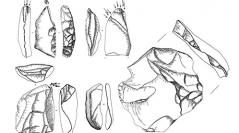

 Comptes Rendus Palevol
18 (4) - Pages 465-478
Comptes Rendus Palevol
18 (4) - Pages 465-478The northern edge of the Iranian Central Desert has provided valuable evidence of terminal Pleistocene human settlements. Mirak constitutes one of the largest open-air lithic scatters in the region, consisting of eight natural mounds. Fieldwork was initiated in 2015 by the joint Iranian-French program at Mirak 8. Preliminary results have demonstrated at least three successive phases of human occupation during the MIS3: an upper layer with clear Upper Paleolithic affinities and a maximum age of 28 ky, a lower layer with clear Middle Paleolithic affinities that dates around 47 ky, and an intermediate layer with mixed characteristics that can be seen as an intermediate Paleolithic phase which dates between 28 ± 2 and 38 ± 2 ky. At the time when Upper Paleolithic cultures originated in the Zagros Mountains, cultures with clear Middle Paleolithic affinities persisted nearby along the northern edge of the Iranian Central Plateau.
Iranian Central Desert, Middle and Upper Paleolithic, Mirak, Late Pleistocene, Semnan